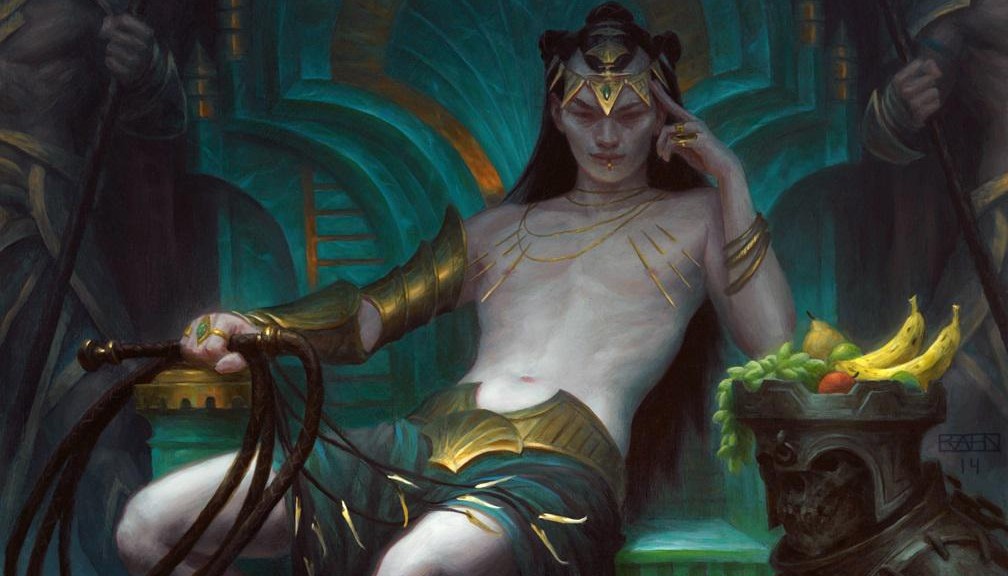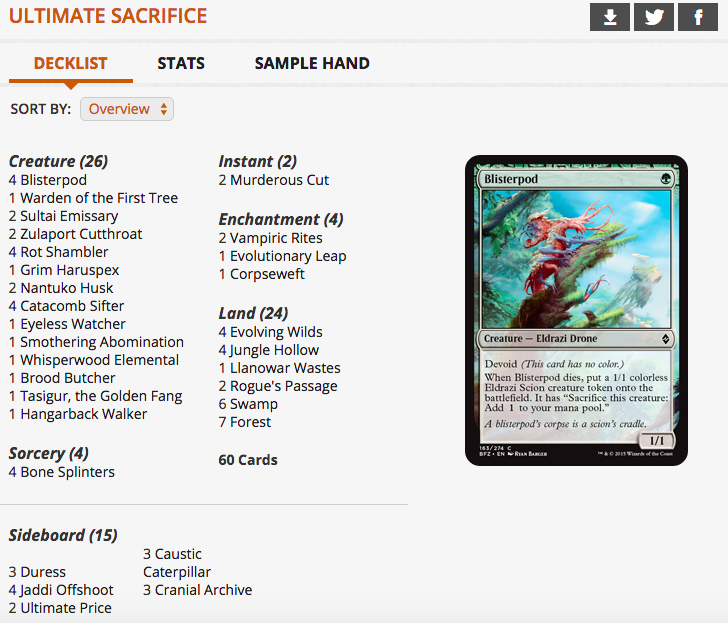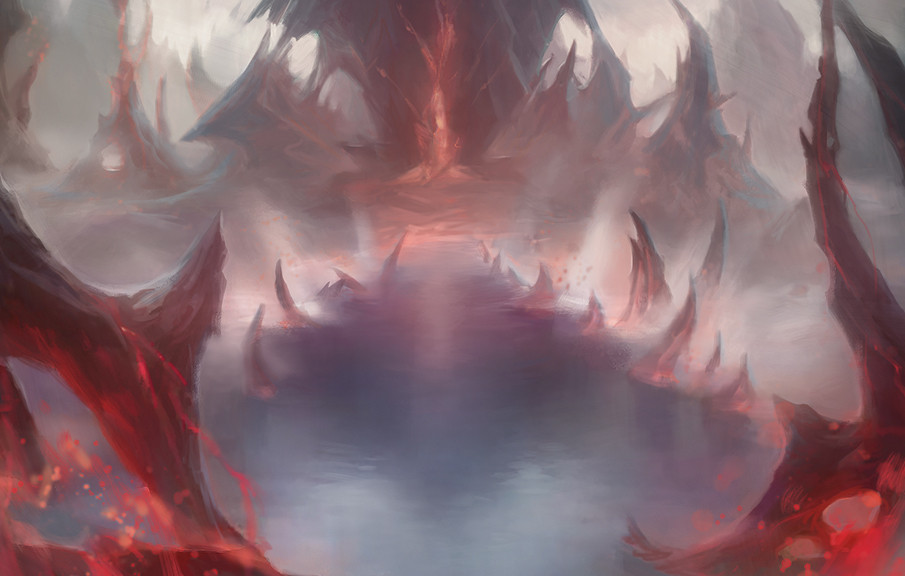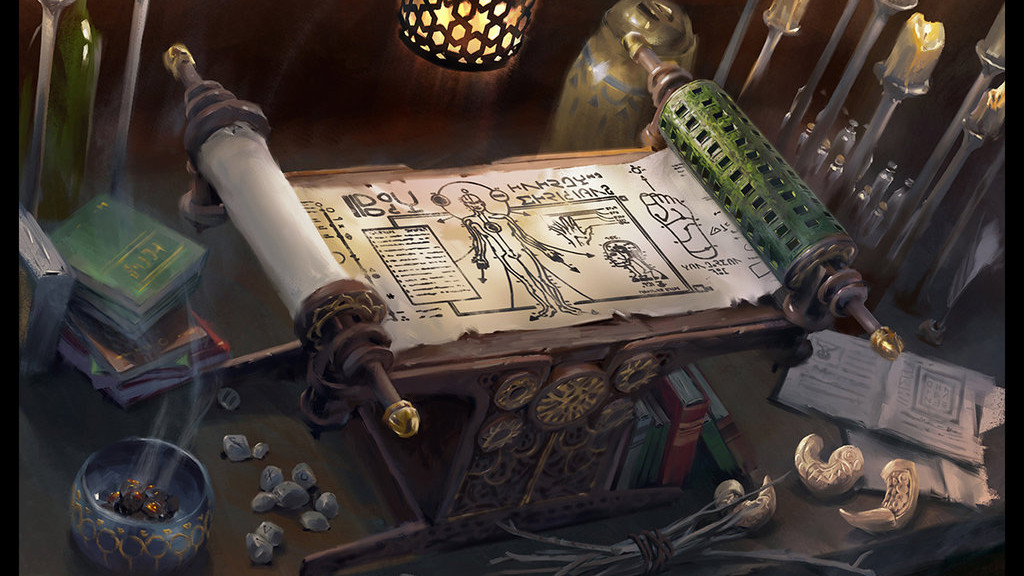Well, we’ve almost made it. It’s the day before the midnight prerelease of Battle for Zendikar, and I can’t remember the last time I was this excited for a prerelease. I feel like a 2.5 on an excitement scale of one to ten, which is saying something. I haven’t gone to a prerelease in exactly a year; Khans of Tarkir was the most recent one that I attended, and that was just because my fiancée and I were bored and needed something to do on our weekend away together. There’s about a 25-percent chance that I’ll end up going to the Battle for Zendikar prerelease with her for the same exact reason.
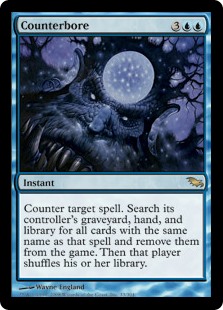
But hey, Wizards is getting there with its marketing. A 25-percent chance is better than nothing.
Shameless Set Review Plug
Now that we’re this close to the wire, I’m thankful that I don’t have to dedicate an entire article or two to a set review. With our spoiler coverage, Jason Alt and I have been taking care of that throughout the past several weeks, a little bit at a time. The small dosage of spoilers each day prevented us from being driven insane at the thought of doing entire set review articles, so I’ll just link our coverage here in case you missed it and are just dying to read about Battle for Zendikar cards today. Jason and I restricted ourselves to all of the rares (and a few cool uncommons), but you can find the complete card image gallery here.

All in all, I’m pretty apathetic about the set. There are a few cards that I’m excited to add to a couple of my EDH decks (Smothering Abomination for Savra, and new Drana for Marchesa), but I’m overall disappointed at the lack of material for my Child of Alara lands deck that I keep talking about.
Our wide staff of writers (I mean, I’m saying that we have a lot of writers, not that all of us are fat…), including myself, have been covering Battle for Zendikar a ton in these past few weeks, so I’m sort of already Zendikar‘ed out. Last week I got a huge positive response wave to my Reddit Q&A/mailbag article, which made me incredibly happy. I really appreciate all of the comments and messages that I received, and it especially works out because I really enjoy writing articles that answer specific questions that allow me to go into a lot of depth with a single answer. Because of that, I want to test the waters with a second article that picks questions from the same weekly r/mtgfinance weekly AMA to see where it takes us.
I’m not sure why the text is so small on these screenshots that I took of the Reddit comments, so I copied and pasted the users’ questions into the article itself to make them readable.
$30 for a Set Symbol

I’ve been wondering for some time as to why there can be such huge price variation of a certain (near identical) card that is printed in multiple sets. I.e. Urborg, Tomb of Yawgmoth has been printed three times: Planar Chaos, FTV Realms and M15 and these are the trade values of the foils from the different sets (from mtgprice.com):
Planar Chaos: $47.75 FTV Realms: $12.98 M15: $14.70
Now that’s some huge differences for the same card that has the same art and flavor text. If they’d had different art, I would have no problem understanding the differences – but they don’t. If anything, I believe the M15 version should be the highest valued because of the hologram (which makes it a whole lot harder to fake).
Hence, my question: Do people really pay $30 extra just for a certain icon on the card or has the card prices just not evened out yet?
—dramak1ng
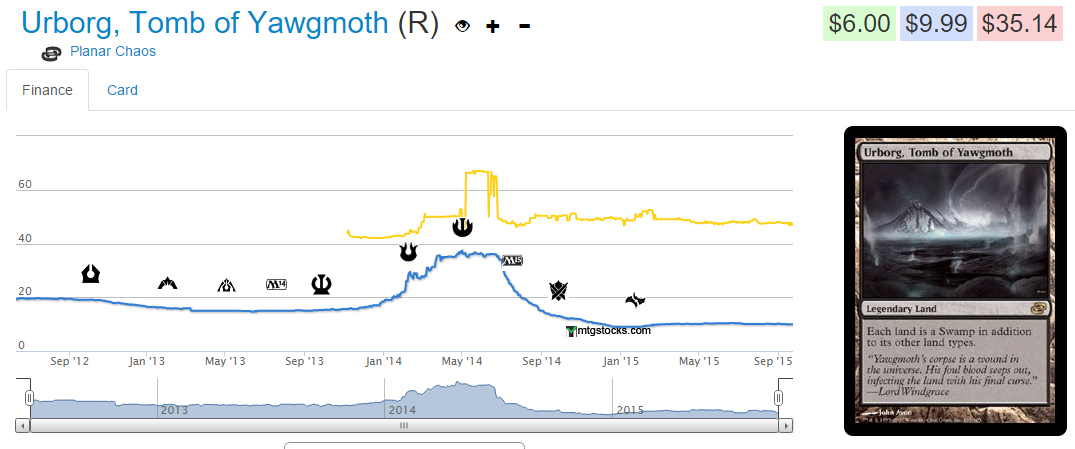
If you’ve ever foiled out an EDH deck before, you might have noticed that original set foils are often a lot more expensive than their reprinted counterparts. While this can usually be explained partially through different a different card frame, art, or even flavor text, there are a significant number of original set foils whose price remains a huge degree higher than the reprinted version, even when they have the same art.
Reddit user dramak1ng asked if people really are willing to pay $30 extra for a certain set symbol, and the simple (yet somewhat unsettling) answer is yes. There are people out there who are still willing to pay $45 for a foil Planar Chaos Urborg even though the $15 M15 version exists and has the hologram at the bottom of the card. The first reason behind this is the same reason people buy foils in the first place: they want their decks to be the best, regardless of how much money needs to be spent to make it happen. Even when that small difference between the two cards is the set symbol, there’s a sense of pride and honor in your opponent asking to read your card, and being able to say “Yeah, that’s the $50 one. It’s from Planar Chaos and there are a lot fewer copies out there than the other versions.” Does it make sense to most of us? Hell no. I’m not going to shell out for black bordered ABU duals for Child of Alara just to gain bragging rights.
The other part of the equation is one that I can relate to more. I actually own a Planar Chaos foil Urborg, and it sits in my Savra deck. I’ve had the thing for god knows how many years, and I probably traded for it back when it was at $20 or $25. I remember when it was worth $65 for that brief period around Journey Into Nyx right before it was reprinted, and I was so tempted to sell it, but I just couldn’t do it. Now that the M15 version is out and the price has dropped to $45, I can’t bring myself to sell it for any less. Yes, price memory is a very real thing.
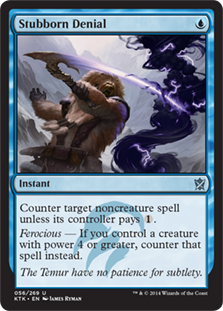
Price memory is a reflection of how strongly a card is tied to a specific price in the mind of the Magic-playing community at large, regardless of what that value actually “should” be based on pure supply and demand. If a bunch of players like me own foil original Urborgs and think that they should be worth $45 even though they rarely sell for that much, then the price will remain close to that just because of an unwillingness to sell for anything less. This is one of the reasons why original set foils are much safer of an investment than anything other than reserved list staples, but they are a lot harder to find the right market for. Their value is theoretically harder to kill than later reprinted cards, but you have to work a lot harder to find that one guy who cares enough about shelling out for the original version.
Using Fat Stacks to Buy Fat Packs

I’m not sure how the printing for Fat Packs works; I’ve heard somewhere that they were only printed once. I’m seeing some really ridiculous prices for them here (60$CAD+taxes…) but I’ve managed to find some for 45$. Should I be buying them now, or waiting until the hype dies down a bit?
—Azuriae
Yes, you heard correctly. Fat Packs are printed in a single run (albeit an enormous one), and once that print run is done, there aren’t anymore. The world can theoretically run out of Fat Packs, and Wizards will be be all dried up. However, I highly doubt this will happen. Wizards knows that there will be a large demand for this specific product because of the full-art lands that will be included, and there will be a huge number of Fat Packs available.
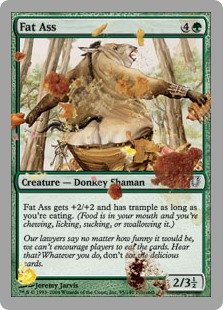


They aren’t a limited release product like From the Vault, either, so you should be able to still find them at Wal-Mart, Target, or any other large retail store should your LGS happens to be sold out.
I really don’t think you should be shelling out over MSRP for Fat Backs, booster packs, boxes, cases, or anything from Battle for Zendikar. Take some deep breaths. There will be enough to go around. If you do want to buy some Fat Packs at MSRP, I wouldn’t recommend holding onto them as spec targets either. Just because there’s a single print run doesn’t mean that you will be able to find buyers willing to pay above MSRP several years down the road. At that point, people would rather just buy booster boxes, and the full-art basic lands will be a dime a dozen. Don’t speculate on fat packs.
Phyrexian Judge Foil Panic

The Phyrexian language Elesh Norn, Grand Cenobite just dropped like 40 dollars overnight. That’s about 5% of its total price. Is there any reason why? If I want it, should I keep waiting for it to drop?
—green_circles
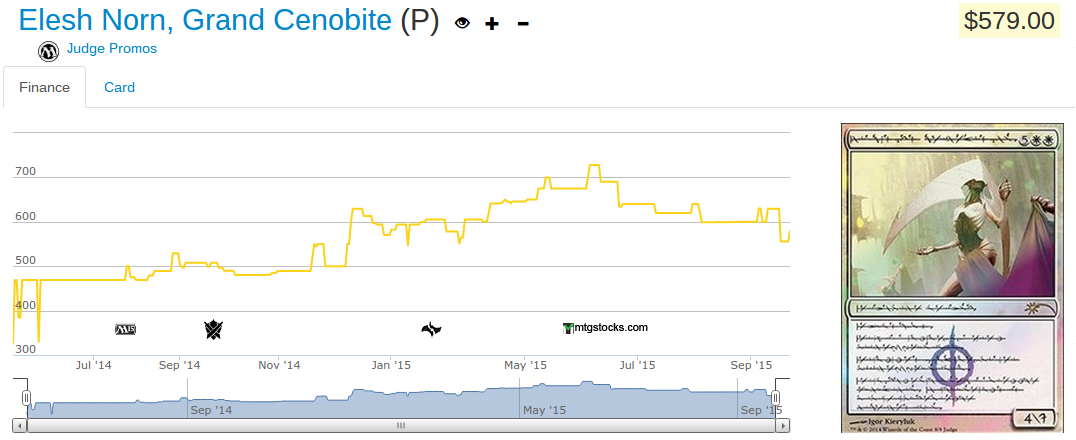
Man, I will never get over how cool that text is. I highly doubt that they’re ever going to reprint Norn in such a way ever again, at least for several years. While there may have been a blip on the radar that suggested Norn was going down a bit in price, remember that there are an extremely small number of copies of these on the open market, and that any slight change in inventory by sellers on TCGplayer and eBay can cause the card to look like it’s trending somewhere.
Nothing has happened in recent times that would suggest the card is any less popular on a grand [cenobite] scale, so I would just mark it up to a small number of sellers deciding to undercut the market to move their copies as quickly as possible. There are only four sellers on TCGplayer right now, and MTG Deals has, well, a pretty good deal considering the fair trade price of the card. If you’re looking to pick one up for cube or EDH, now doesn’t seem like a bad time. The card probably isn’t going to be getting any significantly cheaper over the next few years.
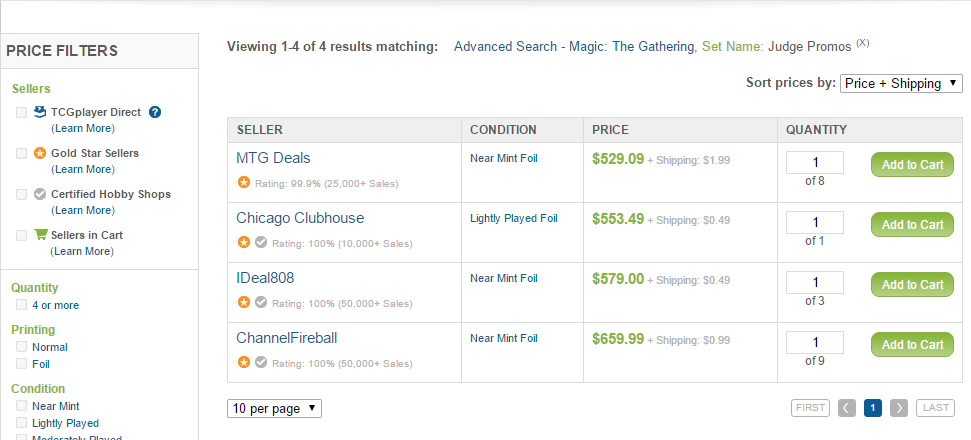
Need vs. Want

If I need a playset of [[Shambling Vent]] for Abzan but would be okay waiting a couple weeks if it were worth it, should I buy in at $4.25/ea or wait a couple weeks? How about [[Canopy Vista]]?
—mtg1200
Sorry mtg1200, but the r/mtgfinance subreddit doesn’t have its own cardfetcher bot.
In your situation, there isn’t really a right answer that I can tell you right now. I mean, there is, but I’d be guessing. I need more information provided in your question. How badly do you need those cards for the opening week of Battle for Zendikar? Are you going to grind a bunch of events in the first few weeks of the set’s release, and do you feel confident in your skill level and deck construction to take all of them down? If so, then your investment of $17 for a playset of Shambling Vents could very well pay off (although I question the necessity of an entire playset of that card in Abzan… maybe it’s a one- or two-of?).

However, if you just want them for one or two small, local FNMs, then you might want to hold off on the investment until a lot more product floods the market. I wrote this article over six months ago, but it’s still one of my favorite shorter pieces that I wrote for Brainstorm Brewery: Rent a Card. The TL;DR of the article is that when you invest in a card knowing that its price will likely decline, you’re basically paying to “rent” the card for those few weeks. The price of renting is your initial cost of payment subtracting the amount you eventually sell the card for. While you could just wait until those numbers will cancel out and be zero, you’re hoping to obtain an intangible play value out of the card that will make up for the overpriced amount you paid at release.
End Step
In other news, Hardened Scales continues to climb. It’s up to $3.50 fair trade price as of today, and I’m on the fence as to whether or not I should sell my copies. I’m leaning towards selling them if I can get $3 a piece, but who knows. Maybe there will be a competitive Standard list that plays it after rotation and makes me bite my tongue.
After seeing the entire set spoiled, I’m less bullish on Dragon Whisperer at $3. We don’t have a Lightning Strike or Searing Spear for the first time in a while, so I’m not sure if mono-red will have the burn it needs. I still like Whisperer as a trade target at $3, and I still think you should pick them up now if you’re adamant about playing Mountains post rotation. I’m just done picking up any more right now (disclosure: I have 10 copies), and I don’t think buying large quantities is the correct move at this point.
Questions? Comments? Concerns? There’s a section for that stuff, you know.

